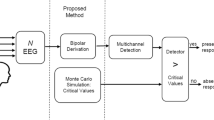Abstract
Purpose
Objective response detection (ORD) techniques assess if evoked potentials are embedded in the background electroencephalogram (EEG). If each technique gives its result, then it is necessary to check which test performs it better. Therefore, a methodology derived from Monte Carlo (MC) simulation was proposed to compare five ORD techniques.
Methods
It was based on estimating the probability of detection (PD) of the tests for the different number of data segments (windows) and with a signal-to-noise ratio (SNR) ranging from − 40 to 0 dB. Moreover, an EEG database of subjects under auditory stimulation was used in order to validate the proposed methodology.
Results
The simulation results showed that the detectors that used the neighboring frequency-band to the interest frequency, as the local spectral F test and Hotelling’s T2, have a better PD when the number of windows used is less than about 20. Conversely, when they are compared in cases with a greater number of windows, magnitude squared coherence, and modified Rayleigh test tend to have a higher PD value. These predictions were validated with the EEG signals.
Conclusion
Therefore, this work predicted the performance of detectors only by means of MC simulation, as a function of the number of windows and tuned to an SNR range consistent with the EEG.





Similar content being viewed by others
References
Babhulkar S, Khotari R, Khairkar PH. Atypical waveform morphology in schizophrenia-visual evoked potential as a promising endophenotype. Ind Psychiatry J. 2017;26(2):155. https://doi.org/10.4103/ipj.ipj_37_17.
Bildeman GM, Bhagat SP. Objective detection of auditory steady-state evoked potentials based on mutual information. Int J Audiol. 2016;55(5):313–9. https://doi.org/10.3109/14992027.2016.1141246.
Cebulla M, Stürzebecker E, Werneck K-D. Objective detection of the amplitude modulation following response (AMFR): Detectión objectiva de la respuesta consecuente de amplitud modulada (AMFR). Audiology. 2001;40(5):245–52. https://doi.org/10.3109/00206090109073118.
Champlin CA. Methods for detecting auditory steady-state potentials recorded from humans. Hear Res. 1992;58(1):63–9. https://doi.org/10.1016/0378-5955(92)90009-C.
Chiappa KH. Principles os evoked potentials. In: Chiappa KH, editor. “Evoked potentials in clinical medicine”2nd edition. New York: Raven Press; 1990. p. 1–37.
Dobie RA, Wilson MJ. Analysis of auditory evoked responses by magnitude-squared coherence. Ear Hear. 1989;10(1):2–13. https://doi.org/10.1097/00003446-198902000-00002.
Fridman J, Zapulla R, Bergelson M, Greenblatt E, Mails LF, Hoeppner T. Application of phase spectral analysis for brain stem auditory evoked potential detection in normal subjects and patients with posterior fossa tumors. Audiology. 1984;23(1):99–113. https://doi.org/10.3109/00206098409072825.
McComick B. The medical practitioner’s guide to paediatric audiology. Cambridge University Press; 1995.
Melges DB, Infantosi AFC, Miranda de Sá AMFL. Using objective response detection techniques for detecting the tibial somatosensory evoked response with different stimulation rates. J Neurosci Methods. 2010;195:255–60. https://doi.org/10.1016/j.jneumeth.2010.12.003.
Miranda de Sá AMFL, Infantosi AF, Simpson DM. Coherence between one random and one periodic signal for measuring the strength of responses in the electroencephalogram during sensory stimulation. Med Biol Eng Compu. 2002;40(1):99–104. https://doi.org/10.1007/BF02347702.
Moore RB. A modification of the Rayleigh test for vector data. Biometrika. 1980;67(1):175–80. https://doi.org/10.1093/biomet/67.1.175.
Müller SMT, M de Sá AMFL, Bastos-Filho TF, Sarcinelli-Filho M. Spectral techniques for incremental SSVEP analysis applied to a BCI implementation. Proc. 5th Latin American Congress on Biomedical Engineering. 2013;33:1090–93. https://doi.org/10.1007/978-3-642-21198-0_277
Picton TW, Vajsar J, Rodriguez R, Campbell KB. Reliability estimates for steady-state evoked potentials. Electroencephalogr Clin Neurophysiol. 1988;68(1987):119–31. https://doi.org/10.1016/0168-5597(87)90039-6.
Ramos EG, Zaeyen EJB, Simpson DM, Infantosi AFC. Detecção da resposta auditiva no EEG de crianças utilizando técnicas no domínio da frequência. Revista Brasileira De Engenharia Biomédica. 2000;16(3):127–37.
Romao M, Tierra-Criollo CJ. A bayesian approach to the spectral f-test: application to auditory steady-state responses. Comput Methods Programs Biomed. 2019;183:105100. https://doi.org/10.1016/j.cmpb.2019.105100.
Santos TS, Silva JJ, Lins OG, Melges DB, Tierra-Criollo CJ. Detection efficiency of audiology steady state evoked by modulated noise. Hearing Research. 2016;339:125–31. https://doi.org/10.1016/j.heares.2016.05.017.
Shalash AS, Hassan DM, Elrassas HH, Salama MM, Méndesz-Hernádez E, Salas-Pacheco JM, Arias-Carrión O. Auditory-and vestibular-evoked potentials correlated with motor and non-motor features of Parkinson’s disease. Front Neurol. 2017;8:55. https://doi.org/10.3389/fneur.2017.00055.
Simpson DM, Tierra-Criollo CJ, R. T., Zayen, E. J., and Infantosi, A. F. Objective response detection in an electroencephalogram during somatosensory stimulation. Ann Biomed Eng. 2000;28(6):691–8. https://doi.org/10.1114/1.1305530.
Tai TYT. Visual evoked potentials and glaucoma. Asia Pac J Ophthalmol. 2018;7:352–5. https://doi.org/10.22608/APO.2017532.
Valdes JL, Perez-Abalo MC, Martin V, Savio G, Sierra C, Ee Rodriguez, Lins O. Comparison of statistical indicators for the automatic detection of 80 hz auditory steady state responses. Ear and hearing. 1997;18(5):420–9.
Xi J, Chicharo JF. A new algorithm for improving the accuracy of periodic signal analysis. IEEE Trans Instrum Meas. 1996;45(4):827–31. https://doi.org/10.1109/19.517004.
Zurek P. Detectability of transient and sinusoidal otoacoustic emissions. Ear Hear. 1992;13(5):307–10.
Acknowledgements
The authors would like to thank Tiago Zanotelli, who contributed with clarifications regarding the computing process.
Funding
This research received financial support from the Brazilian agencies CNPq (grant 312592/2020–5) and FAPERJ (grants E-26/202.587/2019 and SEI-260003/001142/2020).
Author information
Authors and Affiliations
Contributions
Marcos Aurelio Freire Ferraz Passos, Felipe Antunes, and Leonardo Bonato Felix have contributed to the study’s conception and design. Antonio Mauricio Ferreira Leite Miranda de Sá has evaluated this work concerning mathematical and statistical analysis. All the authors have read and approved the final manuscript.
Corresponding author
Ethics declarations
Ethics approval
The Local Ethics Committees IFF-FIOCRUZ/MS and CEP/UFV (1.616.098) approved this research.
Consent to participate
All volunteers gave written informed consent to participate.
Conflict of interest
The authors declare no competing interests.
Additional information
Publisher's Note
Springer Nature remains neutral with regard to jurisdictional claims in published maps and institutional affiliations.
Supplementary Information
Below is the link to the electronic supplementary material.
Rights and permissions
Springer Nature or its licensor holds exclusive rights to this article under a publishing agreement with the author(s) or other rightsholder(s); author self-archiving of the accepted manuscript version of this article is solely governed by the terms of such publishing agreement and applicable law.
About this article
Cite this article
Passos, M.A.F.F., de Sá, A.M.F.L.M., Antunes, F. et al. A new approach to predict the performance of objective response detectors from Monte Carlo simulations. Res. Biomed. Eng. 38, 1113–1119 (2022). https://doi.org/10.1007/s42600-022-00243-x
Received:
Accepted:
Published:
Issue Date:
DOI: https://doi.org/10.1007/s42600-022-00243-x




